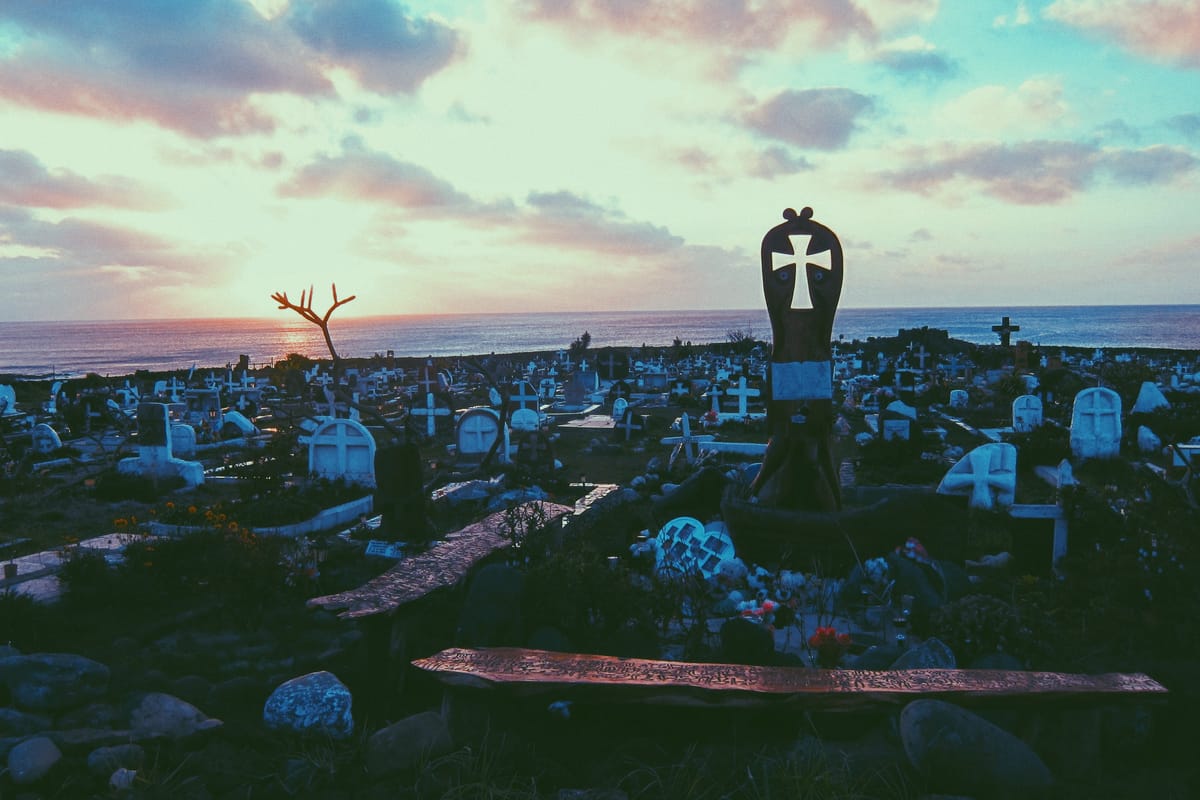Moai, Hanga Roa and Welcomes

Place: Hanga Roa
Fat globs of rain slap against the multi-coloured fishing boats at rest in the tiny harbour. They don’t catch much fish here, it is either flown from Santiago, or frozen and shipped on the boat that arrives once a fortnight, the day the stores have stock on their shelves, rather than optimistic space for bread and corn, tomatoes and eggs.
It is early, the morning after a national holiday, and the empty ramada flaps white plastic, abandoned a few hours ago as the sun scratched the caldera, the drums fell silent, and there was only the wind. It is a constant. Howling off the Pacific, in conversation with the moai that face away, squat, sulky children with stony expressions, backs turned.
The rain is somewhat less consistent. It has a monsoonal quality, in that binary sense of nothing between clear and torrential, on or off. A reminder of the power of nature, as if you could forget in a place where climbing the hill at the end of the street grants you a view of the crossroads, the pier, and then endless ocean in every direction.
A gust pushes the rain sideways and sends me ducking between the awnings of a series of half-finished concrete block storefronts. This is a one-town island and the architecture is uncertain, tentative. A dominant style has yet to take hold, so local entrepreneurs experiment with concrete slabs in tumbles of proto-brutalism.
A Kings of Convenience song of a few years past issues from a tinny speaker wired to the roof by a long, frayed cable that stretches under the door of a shuttered cafe. Under the awning a guy with a neatly trimmed beard ineffectually leans on a broom, the only thing moving along the whole street.
I stare at him and then at the speaker, disoriented. “It’s a good song, no?” he says. “It is! How do you know them?” I ask. “Oh, I lived in Spain, a share house, my roommate was just crazy about them.” “But you were born here?” “Yes. Like everyone I left. Like everyone, I came back. Where are you staying?” “Just next door. The blue gate.” “With Matias? Has he told you about the film?”
Pathways
One
The film in question is the 1994 Kevin Reyonds epic Rapa Nui, which bought a giant Hollywood production to an economy and community poorly equipped to deal with it. Not five minutes after I met him, Matias had launched into vivid stories of the various scandals and multi-generational feuds the movie had spawned on the island.
Despite the drama off screen, the film presents a (broadly) historically accurate portrayal of how deforestation lead to a complete societal collapse on the island. This brings us to two perfect pieces of NYT content with 24 long years between them.
The first, Janet Masin's wonderful review of Rapa Nui, includes the line "the dives are dramatic and perilous, the vistas genuinely lovely, and the egg-smashing pratfalls at a relative minimum."
The second is an astounding piece of contemporary news design, Easter Island is Eroding, which pulls no punches in its portrayal of the dire thread climate change poses to both the people and the archaeological heritage on the island.
Two
To this little guy 🗿 and the rather curly issue of context drift and emoji interpretation. While our friend the Moai wasn't in the initial set of 176 emoji developed for Docomo by Shigetaka Kurita in 1999, it followed shortly after on all the major Japanese carriers.
You might wonder why a designer would attempt to convey a giant rock head in a extremely memory limited context. Well, mostly because old mate Moai is actually Moyai, the creepy giant stone head on the uncool side of Shibuya station. A single emoji answer to "Where should we meet?" when you are trying to avoid the thronging hachiko masses was as convenient in 2001 as it is now.
Unfortunately someone missed the message and by 2002 there was thematic divergence as to what the Moai was supposed to represent, with au heading straight for the rapa nui special (see #794). By the time unicode 6.0 rolled around in 2010 it was anyone's guess with every vendor taking a stab at island or urban.
Three
A cool thing about the Moyai statue is it's made from a very particular kind of rock, koukaseki, which is quarried on one of Tokyo's rather more outlying suburbs, the island of Nijima. In English it's a xenolith, a rock formed of inside other rocks. Check this insanely badass sentence from wikipedia: "xenoliths can be non-uniform within individual locations, even in areas which are spatially limited, e.g. rhyolite-dominated lava of Niijima volcano contains two types of gabbroic xenoliths." Oh, and in local dialect, Moyai means "work together." Nice, nice. 🗿🗿
Postscript
And that's it for the first episode (stop me before I get to Rongo Rongo). Next one in a fortnight where we'll be digging deep into shop basements and share bicycles. Let me know what you think of the format / feels by replying to this email.
